A familiar sight caught my eye as I was going around the baranggay center. There pasted on the wall of their function room was a large sign that spelled AIKIDO, The Way of Harmony. An aikido dojo here in BF! Why have I not seen this before in my three years in BF? I took down all of the pertinent data and promised to come back.
When I walked in on a Monday afternoon just after 5:30 p.m. for the start of their warm-ups, a flood of memories swept me almost 15 years back to the time I first enrolled in a Makati dojo. I knew I wanted to take up martial arts but didn't exactly know which one. I knew what I did not like--judo and tae kwon do. I finally settled on Aikido.
Because we used the harder puzzle-mats instead of the softer foam-lined rubber mats normally found in many dojos, it felt like we practicing on soft ground. That and the constant parrying movements resulted in my waking up a month later and finding big bruises on my arms and legs. Somehow that brought home to me the martial aspect of this budo or martial arts.
When I walked in on a Monday afternoon just after 5:30 p.m. for the start of their warm-ups, a flood of memories swept me almost 15 years back to the time I first enrolled in a Makati dojo. I knew I wanted to take up martial arts but didn't exactly know which one. I knew what I did not like--judo and tae kwon do. I finally settled on Aikido.
Because we used the harder puzzle-mats instead of the softer foam-lined rubber mats normally found in many dojos, it felt like we practicing on soft ground. That and the constant parrying movements resulted in my waking up a month later and finding big bruises on my arms and legs. Somehow that brought home to me the martial aspect of this budo or martial arts.
But aikido as a martial art has undergone a series of transformations almost right from its inception because of a perceived "lack of realism in training," and therefore it is seen by many to be inapplicable in real combat.
Students of the founder, Morihei Ueshiba, also known as Osensei or Great Teacher, diverged from his techniques and styles and created their own schools even while he was still alive.
Today, the schools and styles range from the soft to the hard forms, with some even incorporating competitions, contrary to the spirit of the founder.
Students of the founder, Morihei Ueshiba, also known as Osensei or Great Teacher, diverged from his techniques and styles and created their own schools even while he was still alive.
Today, the schools and styles range from the soft to the hard forms, with some even incorporating competitions, contrary to the spirit of the founder.
Deriving mainly from the martial art, Daitoryu Aiki-jujutsu, Ueshiba branched out and "envisioned aikido not only as the synthesis of his martial training, but also an expression of his personal philosophy of universal peace and reconciliation."
Its teaching centers on defending yourself while harmonizing with your attacker resulting in as little injury to both as possible. Initially, it seems alien to the popular concept of martial arts where disabling an opponent almost always means delivering a fatal blow. But go deeper into budo philosophy and you will see that your worst enemy is your own ego.
Becoming a passionate aikidoka made me fall in love with many things Japanese. When I continued practicing aikido after temporarily moving in with my parents in Davao City, I created a Japanese-inspired bedroom for myself and bought books on the subject.
Its teaching centers on defending yourself while harmonizing with your attacker resulting in as little injury to both as possible. Initially, it seems alien to the popular concept of martial arts where disabling an opponent almost always means delivering a fatal blow. But go deeper into budo philosophy and you will see that your worst enemy is your own ego.
Becoming a passionate aikidoka made me fall in love with many things Japanese. When I continued practicing aikido after temporarily moving in with my parents in Davao City, I created a Japanese-inspired bedroom for myself and bought books on the subject.
Two of them were It's a Lot Like Dancing: An Aikido Journal by Ueshiba's student, Terry Dobson and Angry White Pyjamas, by Robert Twigger, who chronicled his one-year intensive training in Japan.
I had to laugh when I saw the title of Dobson's book--he said it like it is--Aikido is a lot like dancing, the very description that came to my mind while watching my own sensei twirl around mesmerizingly in a constantly moving circular fashion--it was so aesthetically pleasing and so deadly at the same time.
The nage (thrower) and the uke (receiver) have to harmonize their moves to blend together like a pair of experience dancers in order to effectively execute a technique.
The nage has to adapt and adjust to his or her uke to unbalance and render the uke vulnerable while allowing the uke to exit unharmed by doing an ukemi or a breakfall. While the uke must attack honestly in order to allow his or her nage to apply the technique correctly.
I had to laugh when I saw the title of Dobson's book--he said it like it is--Aikido is a lot like dancing, the very description that came to my mind while watching my own sensei twirl around mesmerizingly in a constantly moving circular fashion--it was so aesthetically pleasing and so deadly at the same time.
The nage (thrower) and the uke (receiver) have to harmonize their moves to blend together like a pair of experience dancers in order to effectively execute a technique.
The nage has to adapt and adjust to his or her uke to unbalance and render the uke vulnerable while allowing the uke to exit unharmed by doing an ukemi or a breakfall. While the uke must attack honestly in order to allow his or her nage to apply the technique correctly.
It's a play on balance that focuses on the role of your hara, or lower belly, said to be the center of your gravity or the center of your balance. A person of gravitas is said to be one who contains a certain dignity and substance. My sensei could not emphasize enough the importance of doing things from your hara, whether physically or spiritually.
How apt then to come across a dojo called the Hara Aikido Dojo. Established in the mid-90s, its longevity is good sign of its success. Sensei Winston Guasch is a 4th dan master who has studied under various Japanese senseis from the Hombu Dojo.
He can switch back and forth between easy camaraderie with his students to sensei-mode in a flash, at home both as a friend and a teacher. And his students respond accordingly.
How apt then to come across a dojo called the Hara Aikido Dojo. Established in the mid-90s, its longevity is good sign of its success. Sensei Winston Guasch is a 4th dan master who has studied under various Japanese senseis from the Hombu Dojo.
He can switch back and forth between easy camaraderie with his students to sensei-mode in a flash, at home both as a friend and a teacher. And his students respond accordingly.
Tess Torres, the dojo's secretary, entertained me the second time I visited the dojo. Showing that it's never too late to take up martial arts, she signed up five years ago as a 39-year-old veteran of gyms and yoga.
"I needed another exercise that made me think. I wanted an exercise that challenged my mental and physical abilities. When I enrolled, I checked out another one just to compare, but of course I live near here so this was really my target dojo."
Not satisfied with what she saw in the other dojo, she happily settled here and has thrived ever since, reaching shodan (1st dan) level two years ago. Her young son, Enzo, now practices with her; her daughter plans to join them next year.
"I needed another exercise that made me think. I wanted an exercise that challenged my mental and physical abilities. When I enrolled, I checked out another one just to compare, but of course I live near here so this was really my target dojo."
Not satisfied with what she saw in the other dojo, she happily settled here and has thrived ever since, reaching shodan (1st dan) level two years ago. Her young son, Enzo, now practices with her; her daughter plans to join them next year.
I immediately noticed the wide range of age groups of the students, from grade schoolers to middle-age enthusiasts. Apart from Tess and her son, there is also a father and son, brothers, and sisters. Tess wants to encourage parents and children to practice together.
The class is almost evenly divided between the genders, says Tess, both ranging in ages as well. I was privileged to be present for the exam of one of them. "When I came here there were two women so it boosted my confidence--they seemed to be ok, they don't seem hurt," she laughs.
Speaking of her sensei, Tess relates that "he makes sure that for beginners, there's a one-on-one with you and him until you learn your correct uke. And then he joins you in the techniques. That's how he teaches you."
The class is almost evenly divided between the genders, says Tess, both ranging in ages as well. I was privileged to be present for the exam of one of them. "When I came here there were two women so it boosted my confidence--they seemed to be ok, they don't seem hurt," she laughs.
Speaking of her sensei, Tess relates that "he makes sure that for beginners, there's a one-on-one with you and him until you learn your correct uke. And then he joins you in the techniques. That's how he teaches you."
Reflecting on the relative unpopularity of aikido, Tess echoes the glaring difference of aikido from other martial arts. "Our culture embraces more of the competitive martial arts. Even in school. If you notice, there's no aikido in schools because schools like competition and competing with other schools like in basketball or volleyball. When there's no competition, generally it's not well funded. Not a lot of people are interested. It's like, for what? There has to be some goal. But the goal here is really for refinement."
But she has no quarrel with MMA, shrugging that if that's what people want, you have to respect them. For her, she has found her niche and sees herself practicing till she's 70.
"It's not about taking down somebody. The self-defense part comes more as a reaction, the evasion. When you're walking down the street, it's more about awareness and reaction (evasion). It's not about doing incredible technique."
But she has no quarrel with MMA, shrugging that if that's what people want, you have to respect them. For her, she has found her niche and sees herself practicing till she's 70.
"It's not about taking down somebody. The self-defense part comes more as a reaction, the evasion. When you're walking down the street, it's more about awareness and reaction (evasion). It's not about doing incredible technique."
"When you're attacked on the street, the first thing you can do is do an atemi (a strike or a feint) on your attacker and if he's disabled, the next thing you should do is to run!. Preservation of life first. Walk with confidence."
"But in a knife attack, practically speaking, the chances of escaping unscathed are probably none. The goal is for you not to get stabbed fatally, but expect a 50% chance of taking a cut. And as much as possible, just disable and not kill," Tess concludes.
My sensei used to tell this story. An attractive woman was walking down an alley when her way is menacingly blocked by group of young men. She confidently walks up to the leader, gives him a big smile, and asks in her most charming voice, "What time is it?" The young man automatically looks down at his watch as if in a trance. Smiling again, she walks past them.
That, my sensei, said is the aikido spirit as embodied in an atemi that unbalanced a would-be opponent without throwing a punch. Osensei would have been proud.
"But in a knife attack, practically speaking, the chances of escaping unscathed are probably none. The goal is for you not to get stabbed fatally, but expect a 50% chance of taking a cut. And as much as possible, just disable and not kill," Tess concludes.
My sensei used to tell this story. An attractive woman was walking down an alley when her way is menacingly blocked by group of young men. She confidently walks up to the leader, gives him a big smile, and asks in her most charming voice, "What time is it?" The young man automatically looks down at his watch as if in a trance. Smiling again, she walks past them.
That, my sensei, said is the aikido spirit as embodied in an atemi that unbalanced a would-be opponent without throwing a punch. Osensei would have been proud.
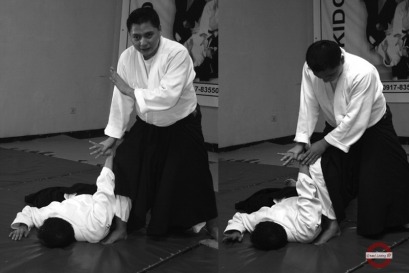
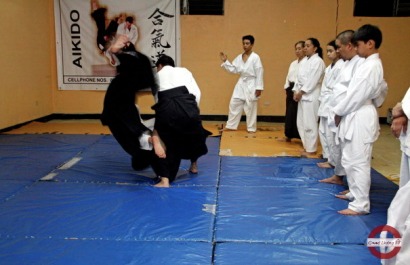
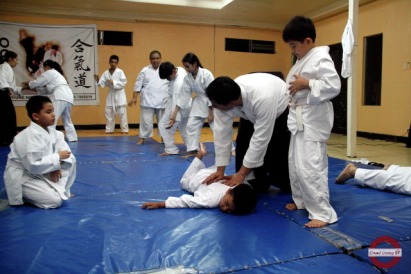
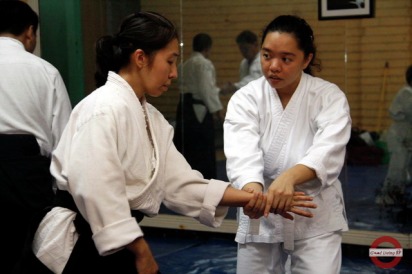
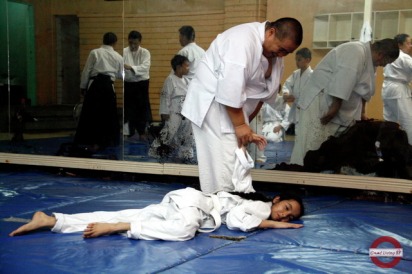

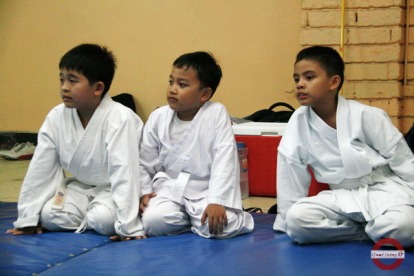
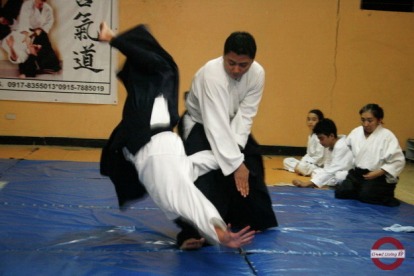
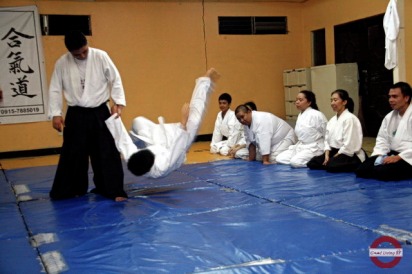
 RSS Feed
RSS Feed